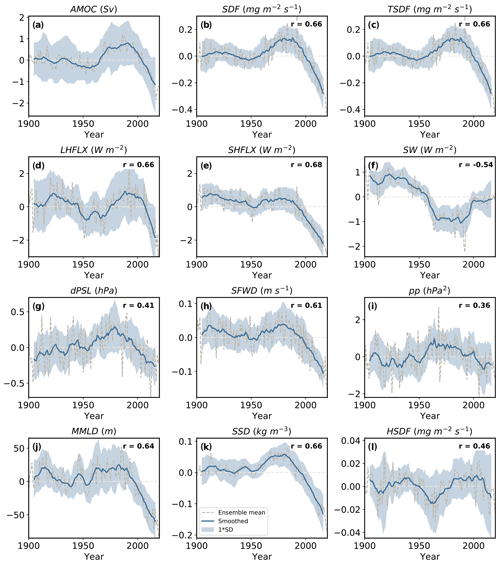En wat met de effecten van een 80% reductie van zwaveluitstoot?
Bericht van: Miguel (Varsenare) , 02-11-2024 21:06Bij deze --->
Toename van aerosols zoals SO2 zou bijdragen aan een sterkere AMOC maar in 2020 moest de scheepvaart de zwaveluitstoot 80% reduceren! Vooral boven de noordelijke Atlantische Oceaan kan dat toch best ook een stevige impact hebben op de AMOC.
.
Uit onderstaande tekst versterkende effect bij meer aerosols --->
however, Menary et al. (2020) use the new Coupled Model Intercomparison Project phase 6 (CMIP6) (Eyring et al., 2016) archive to show a ∼10 % AMOC strengthening from 1850 to 1985, which they attribute to aerosol forcing.
.
En bij afname -->
Furthermore, Ma et al. (2020) find that the projected 21st century decline of anthropogenic aerosols in CMIP5 models induces AMOC weakening. This weakening of ocean circulation is associated with a divergence of meridional oceanic heat transport, which leads to enhanced ocean heat uptake but diminished storage of oceanic heat in the subpolar North Atlantic.
.
Complete stukje over aerosols hier onder + link.
https://acp.copernicus.org/articles/21/5821/2021/
There is considerable debate on the role of anthropogenic aerosols in driving North Atlantic climate variability. One study argued anthropogenic aerosols are the dominant driver of Atlantic Multidecadal Variability (a broad term encompassing Atlantic climate variability), primarily through aerosol–cloud interactions and modification of net surface shortwave radiation (Booth et al., 2012). However, this result was based on a single climate model, the Hadley Centre Global Environmental Model version 2, Earth System configuration (HadGEM2-ES). Subsurface inconsistencies between observations and HadGEM2-ES were also noted, and long-term trends in sea surface temperatures may be too sensitive to HadGEM2-ES's aerosol loading (Zhang et al., 2013). Others have also suggested a role of anthropogenic forcing, including aerosols, in driving Atlantic Multidecadal Variability (Evan et al., 2009; Otterå et al., 2010; Chang et al., 2011; Allen et al., 2015; Murphy et al., 2017; Bellomo et al., 2018). Anthropogenic aerosols may also impact the AMOC, including strengthening the AMOC and increasing the northward cross-equatorial ocean heat transport (Delworth and Dixon, 2006; Cai et al., 2006, 2007; Cowan and Cai, 2013; Collier et al., 2013; Menary et al., 2013; Cheng et al., 2013). Menary et al. (2013) finds AMOC strengthening in response to increasing anthropogenic aerosols using the same HadGEM2-ES model discussed above. They argue that this is primarily driven by increased salinification of the North Atlantic subpolar gyre via increased evaporation, decreased flux of ice through the Fram Strait, and increased salt advection from the subtropical Atlantic. This study, like many of the earlier studies, relies on a single climate model. Very recently, however, Menary et al. (2020) use the new Coupled Model Intercomparison Project phase 6 (CMIP6) (Eyring et al., 2016) archive to show a ∼10 % AMOC strengthening from 1850 to 1985, which they attribute to aerosol forcing. Furthermore, Ma et al. (2020) find that the projected 21st century decline of anthropogenic aerosols in CMIP5 models induces AMOC weakening. This weakening of ocean circulation is associated with a divergence of meridional oceanic heat transport, which leads to enhanced ocean heat uptake but diminished storage of oceanic heat in the subpolar North Atlantic.
.
Zie ook in deze onderstaande afbeelding de toename van de AMOC in de linkerboven afbeelding. Dit tijdens de periode van getemperde opwarming door de luchtvervuiling.
 Quote selectie
Quote selectie